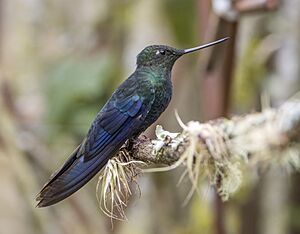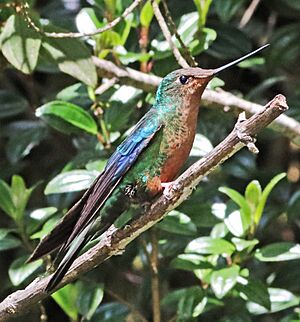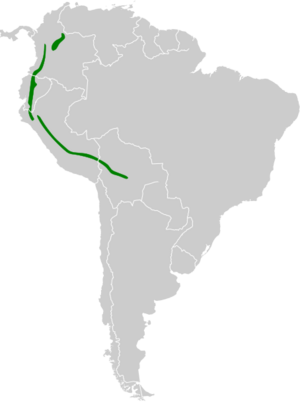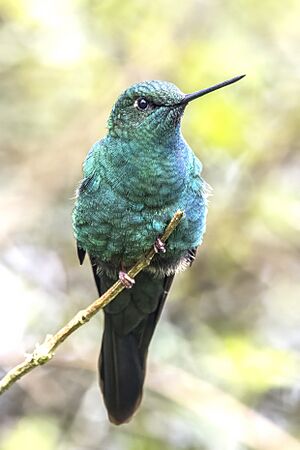Great sapphirewing facts for kids
Quick facts for kids Great sapphirewing |
|
|---|---|
 |
|
| Male Pterophanes cyanopterus caeruleus, Caldas Department, Colombia | |
 |
|
| Female in Yanacocha Reserve, Ecuador | |
| Conservation status | |
| Scientific classification | |
| Genus: |
Pterophanes
|
| Species: |
cyanopterus
|
 |
|
| Synonyms | |
|
Temminck's sapphirewing Pterophanes temmincki |
|

The great sapphirewing (Pterophanes cyanopterus) is a very large type of hummingbird. It belongs to a group of hummingbirds called "brilliants." You can find this amazing bird in South American countries like Bolivia, Colombia, Ecuador, and Peru.
Contents
About the Great Sapphirewing
The great sapphirewing is the only bird in its special group, called Pterophanes. Scientists once thought it might be related to another hummingbird group, Coeligena. But later studies showed they are not closely related at all.
There are three slightly different kinds, or subspecies, of the great sapphirewing:
- P. c. cyanopterus (the main type)
- P. c. caeruleus
- P. c. peruvianus
This bird is also known by other names, like Temminck's sapphirewing or simply sapphirewing.
Appearance and Size
Imagine a really big hummingbird! The great sapphirewing is one of the largest hummingbirds on Earth. Only a couple of other hummingbirds, like the giant hummingbird, are bigger.
This bird is about 15.5 to 19 centimeters (6 to 7.5 inches) long. This measurement includes its long bill, which is about 3.6 centimeters (1.4 inches) long.
- Male great sapphirewings usually weigh between 9.6 and 11.2 grams.
- Females are a bit lighter, weighing from 8.4 to 11 grams.
Both male and female birds have a small white spot right behind their eyes.
Male and Female Colors
Male great sapphirewings of the main subspecies (P. c. cyanopterus) have shiny blue-green feathers on their upper bodies. Their wings are mostly a bright, shining blue, and their tails are greenish-black. Their undersides are also blue-green, but a bit bluer.
Female great sapphirewings of the main subspecies have dark metallic green feathers on their upper bodies. Their heads are a dusky gray. Only the feathers covering their wings are blue; the rest of their wings are dusky. Their tails are mostly greenish-black, with a lot of white on the outer feathers. Their undersides are a warm cinnamon color, mixed with green on the sides.
Subspecies Differences
The P. c. caeruleus males have even more and darker blue colors than the main subspecies. Their females also show more blue, have darker heads, and less white on their outer tail feathers.
The P. c. peruvianus males have more greenish feathers than blue on their upper bodies. Their wings, however, have about the same amount of blue. Their undersides are also greenish, with a light brown belly. The females of this subspecies have a less intense cinnamon color on their undersides and more white on their outer tail feathers.
Where They Live and Their Home
The great sapphirewing lives in different parts of the Andes mountains in South America.
- The main subspecies, P. c. cyanopterus, lives in Colombia's Eastern Andes. You can find it in areas like Norte de Santander and Cundinamarca. It also extends a little into western Venezuela.
- P. c. caeruleus lives in Colombia's Central and Western Andes.
- P. c. peruvianus is the most widespread. It lives from the Western Andes of Colombia, south through Ecuador and Peru, all the way to Cochabamba Department in central Bolivia.
These birds like to live on the edges of wet, evergreen forests and in "elfin forests" (which are dense, stunted forests). They also enjoy shrubby slopes with scattered trees. Sometimes, they even go into the páramo, which is a type of high-altitude grassland, at least during certain times of the year.
They live at high altitudes:
- In Colombia, they are found between 2,600 and 3,600 meters (8,500 to 11,800 feet).
- In Ecuador, they live between 3,000 and 3,600 meters (9,800 to 11,800 feet).
- In Peru, they are found between 2,600 and 3,700 meters (8,500 to 12,100 feet).
- In Bolivia, they mostly live above 3,000 meters (9,800 feet).
Behavior
Movement
Great sapphirewings usually stay in the same area for most of the year. However, some birds might move to lower elevations during the winter months in the Southern Hemisphere.
Feeding Habits
These hummingbirds love to feed on the sweet nectar from many different kinds of flowering plants. Most of these plants are fairly small, but some are larger. In Peru, they seem to especially like a plant called Tristerix longebracteatus. In the Colombian páramo, they often visit Puya clava-herculis.
They usually feed at low to mid-levels of the plants. They can hover in the air or perch on the plant while they drink nectar. They often defend their favorite patches of flowers from other birds. But they also "trap-line," which means they visit a regular circuit of feeding spots. Besides nectar, they also catch small arthropods (like insects) by picking them off leaves or catching them in the air.
Reproduction and Life Cycle
The breeding season for the great sapphirewing is not fully known, but it includes at least February to May. Only one nest has ever been found, and it was quite unusual! It was a three-part nest made of moss and lined with soft fibers.
When this special nest was discovered, a female sapphirewing was taking care of two baby birds in one part of the nest. Another part was occupied by a female tyrian metaltail (another type of hummingbird). The third part was empty. The nest was about 4 meters (13 feet) above the ground, hanging from roots under some plants.
Vocalization
The great sapphirewing makes several different sounds. These include:
- A high, thin, liquid chatter.
- A long, piercing, high-pitched zeee.
- An excited titititirrr.
Conservation Status
The IUCN (International Union for Conservation of Nature) has evaluated the great sapphirewing. They have listed it as a species of "Least Concern." This means that scientists are not worried about it becoming endangered right now.
The great sapphirewing lives across a large area. Even though we don't know exactly how many there are, their population is believed to be stable. No specific threats have been identified that would put them in danger. In different parts of its range, it can be considered rare or locally common.
This bird is sensitive to losing its forest home or if the forest gets broken up into smaller pieces. However, since it can live on the edges of forests, it is less vulnerable than many other birds that live deep inside mountain forests.


